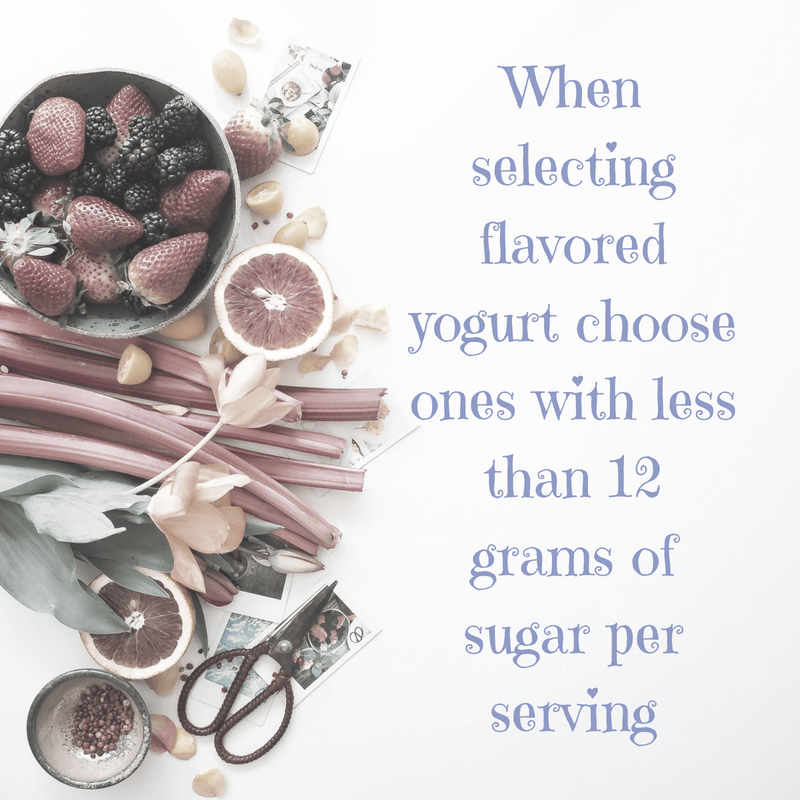How to choose the best yogurt
Who the heck does not like yogurt ? After all the possibilities for its use are endless! It can be used as a base in parfaits, smoothies, soups, pancakes, and can even pinch-hit for sour cream. It is rich in protein and calcium and also contains potassium which is important for ♥ health. Yogurt also contains live, active bacteria cultures. These active bacteria cultures are also known as probiotics and are great for maintaining a healthy gut and digestive system. However, with so many choices choosing the best yogurt can be challenging to say the least!
Navigating the grocery store in search of can be tricky! Need some help grocery shopping? Check out my article on that very topic! I was in Shop Rite the other day and I kid you not – the yogurt aisle almost spans the entire length of the dairy aisle. I remember back in the day – the only two choices were Yoplait and Columbo . There were no flips, dips or cherry pie-flavored yogurts. Just the normal variety of boring flavors like vanilla, peach and strawberry.
Now a days there are SO many different options to choose from. Greek, traditional, flavored, plain, fruit filled, and varying percentages of fat are all factors to consider when buying yogurt. But what do these terms all mean? What is the best one in light of all these choices? Let’s get to the bottom of this madness asap!

What percentage fat yogurt should I buy?
This question is tough. In all honesty – it depends on your #dietarygoals are as well as your overall health.
If you have high cholesterol or are just trying to keep your calories on the low side then choose either a low-fat (1%) or fat-free (0%) variety. These two choices generally have the lowest calorie value and contain a nominal amount of saturated fat. Look for labels that have the lowest amount of saturated fat.

However, if your cholesterol is not an issue and you are just looking for a yogurt with a thicker consistency then opt for a 2 % or full-fat kind.
I personally prefer 2% or full-fat plain yogurt. My favorite traditional brands when I can find them (please don’t laugh 🙂 ) are YoBaby Whole Milk Plain Yogurt or Liberte Plain 2 % Yogurt. Shop Rite generally carries the YoBaby. But lately I can only find the plain Liberte yogurt at Whole Foods. The reason why I like these brands is # 1 (and most important) they taste pretty darn good ! And # 2 both brands contain under 10 grams of sugar. Also they have no added funky ingredients.
Which is best: Greek or traditional ?
Greek yogurt is strained which makes it thicker, creamier, and smoother than traditional kind. When comparing Greek and traditional yogurt, Greek has around double the protein but does have less calcium than traditional kind. Both the Greek and traditional varieties are usually well tolerated by individuals with lactose intolerance. However, the Greek type has less lactose (than traditional) and may be better tolerated than traditional yogurt. Most people prefer Greek to traditional yogurt because of the higher protein content.
Nowadays pretty much every major brand has both a traditional and a Greek yogurt. Even Chobani who started out their career just selling Greek now has a “old-fashioned non-Greek traditional smooth yogurt”. Therefore, you can be brand loyal and still get your pick of the litter!
However, please don’t fret if you just don’t love Greek yogurt! Many of my patients don’t like it and prefer the traditional style instead. Keep in mind – the average American consumes more than their daily requirement for protein. So if you opt for the non-Greek variety you will not be selling yourself short in meeting your protein needs.
Favorite Greek yogurt brands
For the Greek yogurts I personally bounce around brand wise depending upon what is on sale and has the lowest amount of sugar per serving. I shop mostly at Trader Joe’s. But unfortunately (aside from their ‘plain’ Greek) they do not carry a whole bunch of options under 10 – 12 grams of sugar. Some of the Greek style brands in my fridge now are Siggi’s Greek – 2 % Black Cherry, Fage Yogurt-2% plain, and Chobani Plain Whole-Milk Greek Yogurt.
Should I buy plain, flavored, or fruit filled yogurt?
One of the major issues with yogurt is it often has added sugars. It is made from milk (duh!) and therefore has naturally occurring sugar in it, called lactose. Thus, if you look at the nutrition label of plain yogurt, you will notice it has 12 g of carbohydrates. Since this sugar is naturally occurring, it is not of concern. However, what is concerning is the large amount of added sugars in many yogurts. A serving of flavored yogurt can contain an upward of 30 grams of sugar depending on the brand. That is a wholelata sugar! A can of soda has about 24 grams of sugar so the comparison is clear.
How to dodge the sugar
You can skip the added sugars by buying plain yogurt. Then you can be creative and add your own fruit and flavors such as cinnamon and vanilla. Hello fancy pants! You can even go nuts with different extracts such as almond, coconut or coconut to pump up the flavors without the calories or carbs.
When you buy the flavored variety, check the nutrition label and try to buy a containing less than 12 grams of sugar per serving. Some of the brands with the lowest amount of sugars including Dannon Oikos Triple Zero, Chobani Hints, and Siggi’s Greek mentioned above.

Trying to decrease your overall sugar intake? Choose plain yogurt and add your own fresh fruit #squadgoals
Navigating the yogurt aisle used to be challenging! But now, you should be able to navigate the dairy aisle with ease. Opt for low sugar yogurts that fit your dietary goals, budget and taste palate. Selecting an appropriate yogurt should now be pretty easy!
As always, if you have a question bring the nutrition label to your nutrition visit and the dietitian can review it.
What is your absolute favorite one on the market? Tell us what you think in the comments below.
